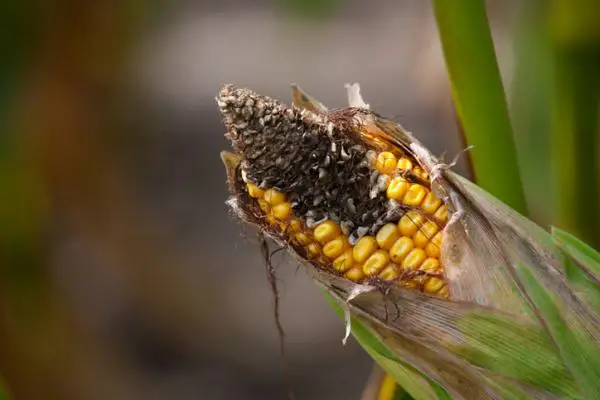Corn is a plant that has been cultivated for approximately 10,000 years by the indigenous peoples of central Mexico. It arrived in Europe in the seventeenth century and since then its cultivation and consumption have spread throughout the world.
So much so, that it is the cereal with the highest volume of production in the world, ahead of such basic products as wheat and rice. Due to this enormous popularity, there are a large number of pests and diseases that have adapted to this plant. In this article we show you what are the pests and diseases of corn and their control , as well as photos of each of them so that you can identify them well.
Gray worm
We start this list of corn pests and diseases and their control with the gray worm. The larvae of butterflies of different species are known by this name . They are about 5 cm in size and curl up in the face of danger. The fight against the gray worm is done with the application of insecticides. To control gray worm pests , we recommend the use of bacillus, which is an ecological insecticide.

Corn drill
This Sesamia moth caterpillar burrows into the plant’s stem and cobs, devouring them from the inside. In order to combat it, an insecticide such as bacillus must be used again, but it is necessary to apply it on the ears as they are growing, since once they are adults the product will not penetrate and it will be late.

Corn aphid, one of the most common pests
This insect is placed on the leaves and spikes of the plant, from which it sucks the nutrients it needs. If the number of aphids is very large, it can affect the production of the plant. The time when aphids attack the most occurs in the warm months. There are many ecological remedies to combat aphids , including garlic infusion, nettle slurry or potassium soap.

Red spider
The spider mite is another of the most widespread pests in a large number of crops and ornamental plants. It is easy to identify due to its striking reddish color and the fabric they build on the underside of the leaves. To combat spider mites in corn, you can increase the humidity in the leaves or you can use sulfur, neem or neem oil, paraffin oil or the always useful potassium soap.

Mice and rats
We continue with this list of corn pests and diseases and their control, focusing now on a few small mammals: rats and field mice.
Depending on the location of the crop, these small rodents may be attracted to your corn plants. Using specialized products is the most expensive and least ecological option, so we recommend that you use natural products such as spurge extract . The tender shoots of this plant, after being macerated for a little more than a week in water, produce a mixture whose bad smell will keep these animals away. In addition, noise and vibrations or moving structures, such as grinders, help to scare them away.

Corn rust
This is the most common disease in corn crops , widespread almost all over the world. It is shown on the leaves, which show yellow stains on both sides, and end up turning shades between red and black. Combating and controlling rust in corn once it appears is very difficult, so the affected plants are usually eliminated and measures are taken to prevent it from reaching the crop, such as the use of varieties resistant to it.

Spike coal
It is a fungus that gets into the plant and does its damage systemically. It is not possible to locate the charcoal spike fungus until the plant grows and shows its spikes, which appear black and deformed, as in the image. This fungus in corn is fought with the application of fungicides, opting better for ecological fungicides.

Rot
The rot can appear both on the stem and on the roots of the plant and, normally, it is due to bacterial agents that produce black areas in the affected parts. In addition, it usually appears when irrigation or humidity is excessive. These bacteria cause a reduction in the harvest and even the wilting of the whole plant. The best way to control rot is to carefully monitor the humidity levels, both environmental and irrigation, and ensure a good drainage of the land to avoid water stagnations.

Mosaic virus, one of the most common diseases of corn
It causes yellow leaves in corn , leaving the nerves of the same very visible and considerably reducing the growth and development of the plant. Since viruses cannot be treated once they have appeared, the only possible measure is to choose maize varieties resistant to these viruses and dispose of the affected plants, always covering them in bags to avoid the spread of spores during transport.

Mushrooms in corn
Aside from charcoal, there are many varieties of fungi that can attack corn . A very good ecological option to combat them is to use homemade fungicide made with milk. In the same way, crop rotation and the use of resistant varieties go a long way to keeping this threat at bay.


